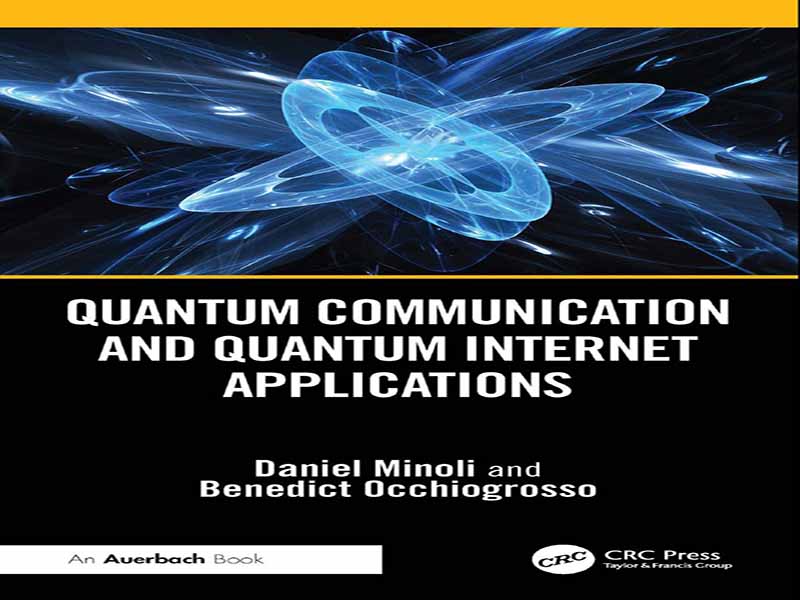- عنوان: Quantum Communication and Quantum Internet Applications
- نویسنده: Minoli, DanielOcchiogrosso
- حوزه: ارتباطات کوانتومی
- سال انتشار: 2025
- تعداد صفحه: 591
- زبان اصلی انگلیسی
- نوع فایل: pdf
- حجم فایل: 13.6 مگابایت
طرفداران، اینترنت کوانتومی نوظهور (Quaint) را «بسیار مورد انتظار» میدانند و در حالی که شبکههای کوانتومی در مقیاس بزرگ/تجاری در حال حاضر وجود ندارند، انتظار میرود تا پایان دهه جاری از استقرار اولیه آنها بهرهمند شوند. محاسبات کوانتومی، به ویژه در ارتباط با سطح بالایی از اتصال که توسط اتصال کوانتومی تسهیل میشود، میتواند مجموعهای از کاربردهای جدید و قبلاً غیرقابل دستیابی را تسهیل کند – این موارد شامل محاسبات کوانتومی کور، تلهپورت (اطلاعات)، همگامسازی ساعت، توزیع کلید کوانتومی، دسترسی ایمن به رایانههای کوانتومی از راه دور، کدگذاری فوق متراکم، شناسایی ایمن، حسگرهای توزیعشده و سایر کاربردهای علمی و تجاری است. هدف این کتاب، معرفی اولیه مبانی و کاربردهای نوظهور ارتباطات کوانتومی برای متخصصان است – این کتاب نه برای محققان، بلکه برای متخصصان ارتباطات از راه دور است. اصول اولیه مکانیک کوانتومی، در یک چارچوب ریاضی مینیمالیستی و عمدتاً مستقل مورد بحث قرار گرفته است. تعداد انگشتشماری از منابع متنی دیگر در گذشتهی نزدیک پدیدار شدهاند، اما هدف ما این است که این علم را برای «فردی با مهارت معمولی در این فن» – یک متخصص معمولی مخابرات – قابل دسترس کنیم و توصیفی بهروز از این رشته ارائه دهیم. طبیعتاً، خواننده نباید انتظار داشته باشد که از یک متن واحد، یادگیری کاملاً جامعی از این حوزه، بهویژه مکانیک کوانتومیِ زیربنایی، به دست آورد. برای خوانندهی علاقهمند، این کتاب میتواند به عنوان نقطهی شروع، همراه با مجموعهای از منابع دیگر که بر جنبههای خاص رشتهی محاسبات کوانتومی و مکانیک کوانتومی تمرکز دارند، عمل کند. پس از یک فصل مروری مقدماتی، فصل ۲ با توصیف برخی از ریاضیات مورد نیاز برای بحث، مفاهیم اساسی در فیزیک کوانتومی را پوشش میدهد، در حالی که سعی میکند ماشینآلات را به حداقل برساند. فصل ۳ با پرداختن به برخی از ریاضیات پیشرفتهتر، اما با نگاهی به وضوح، بحث را ادامه میدهد. فصل ۴ با توصیف برخی از فناوریهای فیزیکی، مفاهیم اساسی در فیزیک کوانتومی را پوشش میدهد، در حالی که علم را نیز به حداقل میرساند. فصل ۵ مروری بر کامپیوترهای کوانتومی ارائه میدهد، زیرا این گرهها نقاط پایانی هستند که توسط اینترنت کوانتومی در افق پشتیبانی میشوند. فصل ۶ بر ارتباطات کوانتومی، از جمله معماریهای منطقی و Quaint تمرکز دارد. در ادامه، در فصل ۷، تلاش میکنیم تا بحثی قابل فهم در مورد امنیت مبتنی بر کوانتومی ارائه دهیم. فصل ۸ اطلاعاتی در مورد ابزارهای نرمافزاری ارائه میدهد که میتوانند برای توسعه برنامههای کوانتومی شبکهای به کار گرفته شوند. واژهنامهها نه تنها اصطلاحات کلیدی در هر یک از فصلها را تعریف میکنند، بلکه مفاهیم مختلف معرفی شده در فصلهای مربوطه را نیز شرح میدهند و باید به عنوان بخشی از فرآیند آموزشی خوانده شوند. این متن به عنوان مروری بر فعالیتهای تحقیقاتی فعلی یا یک آموزش کامل در این زمینه در نظر گرفته نشده است. علاوه بر این، نویسندگان هیچ یک از علوم یا ریاضیات مکانیک کوانتومی را توسعه ندادهاند. بنابراین، مطالب پیشزمینه موجود در تعدادی از فصلها از صنعت به طور کلی سرچشمه میگیرد و منابع اطلاعات به طور کامل ذکر شدهاند. هدف این متن، ترکیب مطالب پیشزمینه و برجسته کردن کاربردپذیری در حوزه نوظهور ارتباطات کوانتومی و اینترنت کوانتومی، به شیوهای قابل فهم است، به طوری که مدیران و سایر افراد غیرمتخصص بتوانند درک اولیهای از این رشته به عنوان زیرمجموعه و کاربردی در حوزه اتصال از راه دور و شبکهسازی به دست آورند.
Proponents refer to the emerging quantum internet (Quaint) as being “highly anticipated”, and while large-scale/commercial quantum networks do not exist at this juncture, they are expected to enjoy some embryonic deployment by the end of the current decade. Quantum computing, particularly in conjunction with a high level of interconnectivity facilitated by quantum connectivity, can facilitate a host of new, previously unattainable applications—these include blind quantum computation, (information) teleporting, clock synchronization, quantum key distribution, secure access to remote quantum computers, superdense coding, secure identification, distributed sensors, and other scientific and commercial applications. This book aims at a basic introduction for practitioners to emerging quantum communications foundations and applications—it is not targeted to researchers but telecommunications professionals. Basic quantum mechanics principles are discussed, within a minimalistic, mostly selfcontained mathematical framework. A handful of other text sources emerged in the recent past, but our goal is to make the science accessible to the “person of ordinary skill in the art”—a typical telecom practitioner— and to provide an up-to-date description of the discipline. Naturally, a reader should not expect to get a fully inclusive learning of the field, especially the underlying quantum mechanics, from a single text. For the interested reader, this book can serve as a point of departure, coupled with a set of other references that focus on specific aspects of the quantum computing and quantum mechanics discipline. After an introductory overview chapter, Chapter 2 covers basic concepts in quantum physics by describing some mathematics needed for the discussion, while trying to keep the machinery to a minimum. Chapter 3 continues the discussion by addressing some more advanced mathematics, but with an eye for clarity. Chapter 4 covers basic concepts in quantum physics by describing some physical technologies, while also keeping the science to a sufficient minimum. Chapter 5 provides an overview of quantum computers, being that these nodes constitute the endpoints to be supported by the quantum internet over the horizon. Chapter 6 focuses on quantum communications, including logical architectures and the Quaint. Next, in Chapter 7, we endeavor to provide an accessible discussion of quantum-based security. Chapter 8 offers information on software tools that can be employed to develop networked quantum applications. The glossaries not only define key terms in each of the chapters, but also elaborate on various concepts introduced in the respective chapters and should be read through as part of the instructive process. This text is not intended as review of current research activities or a complete tutorial on this matter. Furthermore, the authors have not developed any of the science or mathematics of quantum mechanics. Therefore, the background material included in a number of chapters originates from the industry at large, with liberal acknowledgements to the sources of the information. The goal of this text is to synthetize the background material and highlight the applicability to the newly emerging field of quantum communication and quantum internet, in an approachable manner, so that managers and other non-practitioners can get a basic understanding of the discipline as subsetted and applied to the field of remote connectivity and networking.
این کتاب را میتوانید بصورت رایگان از لینک زیر دانلود نمایید.
Download: Quantum Communication and Quantum Internet Applications



































نظرات کاربران